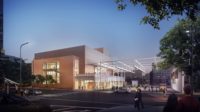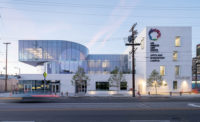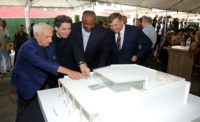Los Angeles Design Center

Photography © Benny Chan / fotoworks

Photography © Benny Chan / fotoworks

Photography © Benny Chan / fotoworks







Architects & Firms
Francisco Pinedo, owner of furniture manufacturer Cisco Brothers, founded his company in a garage 15 years ago. His enterprise has since blossomed into a $15-million-a-year business. The company occupied a number of warehouses in an area of South Los Angeles that has become the heart of the city’s nascent furniture industry. Pinedo needed a showroom, and he thought other manufacturers could benefit from a local presence outside the Westside’s high-rent design district. He asked the architects to design the core of what might grow into a much larger development (one warehouse is completed; the other is still under renovation).
The building itself offered clues about how to proceed. The steel columns, retrofitted on the outside, suggested a scaffolding for what became a new facade of translucent polycarbonate panels, applied like shingles along the length of the facade that faces the parking lot. The architects turned the facade at the front so that it ran parallel to the street, giving the parking lot more closure and the front facade more presence. With this billboard structure, the architects absorbed the notion of visual street language in their design.
A variegated appliqué of horizontal, greenish concrete panels, scaled to be glimpsed obliquely from cars sailing past, signals a refined design sensibility that offers not just cautious reinvestment in the neighborhood, but also authenticity, even joy. The panels wrap portions of the two, two-story brick warehouses and share facade space with what appears to be a billboard partially spanning the parking lot between the two primary structures. Suspended tarps sail above the parking lot like magic carpets, just beyond a fence of punched steel.
Inside, Freidman, the principal in charge, sited a few strategic interventions. Removing a section of the first floor, he placed a hardwood landing, large enough for furniture displays, from which a staircase with transparent siding leads to the second floor. He terraced a section of the second floor (raised to accommodate a loading dock below) to take advantage of the level change. The north side of the terrace was walled off with another layer of shingled polycarbonate panels. All the moves were large, to the point of being environmental.
The most transformative insight was turning the parking lot into a public space. At the Design Center, the lot comprises a watering hole, piazza, and party space with a couple of deft, inexpensive moves. The polycarbonate facades add softness and shimmer to the space; the overhead tarps contain it by defining its height; and concrete parking pads in different shades of gray, separated by planted strips that follow construction lines drawn from the surrounding structures, create a lively patchwork quilt underfoot. Eventually, the parking lot will serve as a point of origin for a path leading to other buildings in the expanded project.
|
People Owner Architect Principal-In-Charge Of Design: Project Architect: Alice Kimm Engineer(s) Structural (Wood Siding, Fence, Gate): Consultant(s) Lighting: Graphic Designer: General Contractor Major Subcontractors Ornamental Steel: Sheet Metal: Photographer CAD system, project management, or other software used
|
Products Exterior Cladding Wood: EIFS, ACM, Or Other: Exterior and interior concrete floors and ground plane, freestanding sign at street Suspended Fabric Canopy above Parking Lot: Glazing Doors Custom Entrance Canopy: Custom Security Gate At Street Entrance: Custom acrylic doors and hardware: Interior Finishes Cabinetwork And Custom Woodwork: – Custom Cabinetry Fabrication: Steel Stair And Guard/Handrails At Foyer: Ronnie Fujinami, The Welding Junction Acrylic Guardrail Panels: Paints and Stains: Special Surfacing: Furnishings Plumbing
|









